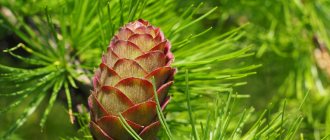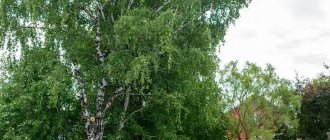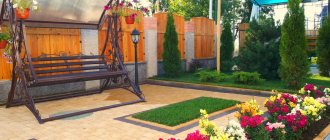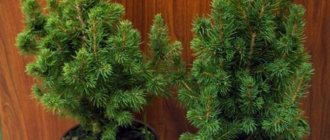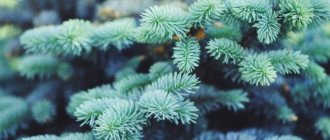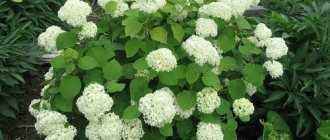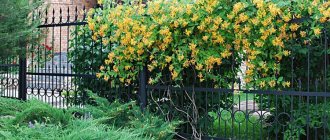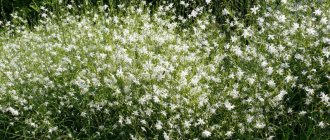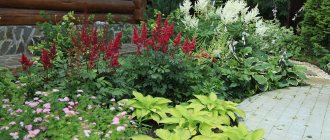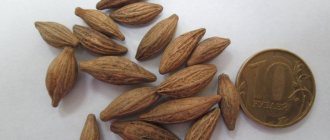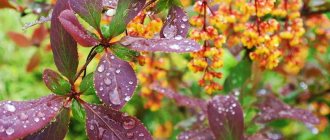Rowan is a spectacular tree, which in the fall becomes a real decoration for the landscape design of a country or garden plot. Its crown is decorated with bright crimson and yellow fruits. Any soil is perfect for the normal growth of this tree.
The height of rowan can be up to 15 m. Its crown has the shape of a pyramid or ball. Young trees have shiny shoots. The length of the green leaves is up to 18 centimeters. The flowers have white and pink shades. They gather in inflorescences. The fruits of this plant are pear-shaped with an average diameter of 3 centimeters. The viscous pulp has a sweet taste.
Landscaping and planting Rowan trees in Moscow
Rowan is not afraid of any frost. Pests do not cause her much harm. Such trees are used in parks and garden plots to create landscape design. There are apple-shaped and pear-shaped plants.
The Kene mountain ash is native to Central China. The height of this plant can reach 3 meters. The tree is decorated with white flowers that frame lush green leaves. The best time to plant Kene rowan is October or April. The soil should be mixed with sand and turf. Sunny areas are perfect for the tree, but shade is undesirable.
The common rowan was brought from the Siberian expanses, where it filled river banks, clearings and forests. The height of the plant with large red and orange flowers can reach 11 meters. This tree tolerates any frost well. Loose soil is perfect for its normal growth. There are several subspecies of this plant, including Russian, Fifeana and Beisnera.
Pomegranate rowan was bred by crossing plants such as hawthorn and common rowan. The height of a tree with pomegranate-colored fruits can reach 4 meters. Intermediate rowan was brought from Central European and Scandinavian countries. In terms of its appearance, it is similar to hybrid rowan. This low plant has a slender trunk and silvery foliage. The flowers have a white tint, and the fruits have a pronounced orange color.
Planting rowan and other trees to create a design
For planting tall mountain ash, the perimeter of the site is most suitable. Plants should not shade it. This tree grows best in light loamy soils. Autumn or spring is suitable for planting it. The distance between trees should be at least 5 m. After the plant is planted, it should be watered thoroughly, and in all subsequent years it is necessary to get rid of side shoots.
Rowan in landscape design goes well with coniferous trees. Ash or willow can also grow next to it. Barberries, spirea and some shrubs can decorate a rowan garden with their presence.
Rowan in landscape design sometimes acts as a tapeworm. In addition, it can be included in groups of plants, decorating their foreground or background. This plant will enhance any home area. Weeping rowan is perfect for creating a beautiful arch that can be used to decorate a gate, bench or gazebo. Weeping plants can also serve as tapeworms. To do this, they need optimally lit areas. You can make beautiful compositions from rowan trees of different types, changing their shape, color of leaves and fruits.
Our company employs experienced professional landscape designers who will be happy to decorate your site with beautiful rowan trees. These trees will not only transform the garden, but will also produce fruits that are beneficial to human health.
Rarely a city park, square, summer cottage, courtyard of a country house, park or recreation area cannot boast of a chic rowan bush. In Russia, everyone has it, like a business card. There are quite a lot of reasons here. The common rowan is a common and beloved deciduous tree, distinguished by its spectacular, eye-catching beauty. It is no coincidence that in landscape design it occupies the top positions in popularity and undeniable advantages. The tree is compact and well formed. Autumn is the peak of the mountain ash charm. Its purplish leaves frame red, yellow or black berry clusters. Such a landscape is worthy only of the brush of a great artist.
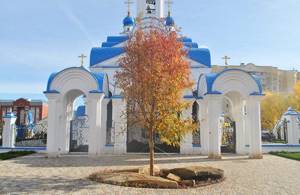
Types of rowan
Native to central China, the Kene rowan grows up to 3 meters in height and has white flowers contrasting with lush green foliage. The tree is planted in mid-spring or autumn, in a mixture of turf, foliage, sand and earth. The plant grows well in sunny areas, but does not do well in the shade.
Common rowan is native to Siberia, in forests, meadows, and river banks. The tree grows up to 11 meters in height and has large orange and red flowers. Resistant to frost, feels better on well-loose soil. Common mountain ash is represented by several subspecies, including Beisnera, Fifeana and Russian.
Pomegranate rowan is a product formed by crossing ordinary rowan and hawthorn. The tree grows up to 4 meters in height, has shiny green leaves and fragrant pomegranate-colored fruits.
The intermediate rowan comes from Scandinavia and Central Europe and is similar in appearance to the hybrid rowan. The tree grows low, with a slender trunk, a decorative crown and foliage of a beautiful silver color. The tree's flowers are white, in inflorescences, the fruits are orange.
Common rowan description
If you add to the unusual beauty the beneficial qualities of the rowan tree that it possesses, then its price cannot be added up. This is a common plant, endowed with decorative properties, invaluable for landscape design. It is also unpretentious to soils, grows and develops well on any of them:
- Its fruits are used in winemaking, folk medicine, pharmacology, and cooking.
- And what irreplaceable help she provides in organizing food for the birds remaining for the winter.
- Rowan can be black-fruited or red-fruited. The first variety can be found in orchards. It has an excellent property - to stabilize high blood pressure.
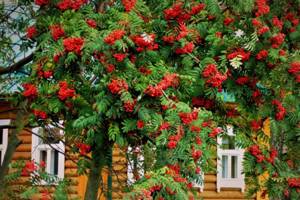
Description of mountain ash
Many summer residents are puzzled by the question: is rowan a tree or a shrub? In fact, this is a tree, less often a shrub:
- The height of the rowan reaches five or ten meters, but can grow up to twelve.
- Its openwork crown is round in shape.
- Young branches are covered with a red edge with a gray tint.
- The mature plant has shiny, smooth yellow-gray or gray-brown bark.
- The tree has a deep root system and does not need to be watered.
Where does the common rowan grow?
Translated from Latin, the word “rowan” means “to attract or catch birds,” since its berries became a kind of bait for catching them. To the question of where the rowan grows, you won’t have to look for the answer for long, since it is distributed all over the world:
- It grows in the Caucasus.
- In Western Asia.
- Well known in Europe.
To understand whether a mountain ash is a tree or a bush, you just need to know that, once in the Far North, it reaches the border in the mountains where the vegetation ends and in these places takes the form of a bush. This suggests that the tree grows in places with a temperate climate, and the shrub grows in the harsh conditions of the North.
Rowan tree or shrub in Russia is common in the forest and forest-steppe zones of European territories, in the North Caucasus and the Urals. You can find her:
- on the edges between bushes;
- in the undergrowth;
- in forest clearings;
- among deciduous and mixed forests;
- it grows alone, without creating thickets.
Russian scientists believe that the rowan tree or shrub is completely unpretentious, since it grows on any soil, even acidic and infertile, but this is reflected in the harvest results. The bush can grow in the sun and in the shade, but the tree will become thinner and reach towards the sun. The tree gets along well with any plants in the summer cottage.

What types of rowan are there?
There are a lot of different types of rowan. There are only 14 varieties of rowan that were bred as a result of breeding work. They were studied by the great Russian biologist I.V. Michurin, who obtained fundamentally new varieties by crossing rowan plants with red shadberry, pear, and hawthorn. The most common species obtained by I.V. Michurin, the following are considered:
- “Michurinskaya dessert”, sweet rowan.
- “Pomegranate”, similar in color to pomegranate.
- "Burka".
- “Liquor” rowan, which has black, sweet berries.
Later, the selection of rowan trees and shrubs began in the city of Michurinsk. Scientists have created varieties:
The varieties were created by crossing the Nevezhinsky and Moravian varieties of mountain ash. Since rowan has been propagating, new varieties of rowan have been created from these two varieties.
In the Russian village of Nevezhino, they discovered non-bitter varieties, like mountain ash. From here these varieties spread throughout Russia. Some were obtained using the folk method and were registered:
Biologist E.M. Petrov was involved in obtaining new varieties of mountain ash and described it, who obtained a number of hybrids:
How to plant rowan
To properly plant a rowan tree or bush, you need to rely on certain rules. To plant trees in the spring, the hole must be prepared in the fall:
- For low-growing varieties, a recess of 80 cm in diameter and 50 cm in depth will be sufficient.
- Vigorous stalks of mountain ash are planted in holes with a diameter of 100 cm and a depth of 60 cm.
- The following is placed in the pit: potassium sulfate (0.1-0.15 kg), superphosphate (0.8-2 kg), manure (20 kg - 2 buckets).
- The soil is mixed well with manure. 2/3 of mineral fertilizers are applied to the bottom, 1/3 is applied to the lower layer of soil, which is poured into a hill.
In order not to injure the plant, mineral fertilizers are not applied to the soil where the roots are. A common rowan tree is planted, the stem of which has reached 130 cm, taking into account its preferences. The best place for it will be the north or east side. When planting several seedlings, the distance between them should be 4 m. In order for rowan to please with a good harvest, you need to choose a sunny place for the plant:
- The plant does not tolerate wet, dry, saline, or peaty areas.
- Groundwater cannot be higher than 2 m.
Seedlings must also meet certain requirements:
- They must be fresh, free of root damage and leaves.
- Their root system should be branched.
- The rowan tree should be 120 cm in height with a trunk diameter of 1.2 cm.
- The standard of two-year-old seedlings is 40-60 cm.
- The root collar is 1 cm in diameter.
- The trunk has a diameter of 2.4 cm.
- 7 large roots 40 cm long.
Characteristics of wood
Rowan reaches up to 15 meters in height, has a spherical or pyramidal crown. While the tree is young, its shoots are shiny and completely bare. The leaves reach 18 cm in length, green and smooth, the flowers are white and pink, collected in inflorescences. Rowan fruits are pear-shaped, approximately 3 cm in diameter, with a sweet, astringent pulp.
The plant tolerates frost well, is resistant to pests, and can be used to decorate private plots and city parks. There are two types of rowan: pear-shaped and apple-shaped.
Rowan care
When caring for a plant, you must remember that the tree trunk circle becomes wider as the tree grows. If its diameter at the time of planting was one and a half meters, then in subsequent years it will be 1 m wider than the crown:
- In the tree trunk circle, it is necessary to dig up the soil in autumn and spring by 10-15 cm, so as not to touch the roots.
- From spring to autumn you need to loosen the soil 3-4 times by 5-6 cm.
- Mulching will retain moisture well. You can fill the tree trunk circle with manure or peat to a depth of 8-10 cm.
When cultivating the soil in the spring, you need to add fertilizers to the tree trunk circle: manure, potassium, nitrogen. When caring for a tree, you can use slurry of manure, diluted in a ratio of 1: 2-3, and bird droppings, diluted in a ratio of 1: 10-12, as a top dressing.
During pruning, broken shoots are removed from the bush. This is done from the beginning of the season, as well as during the fruiting period, when the crown is very thick. If the plant is under control, it is also regularly pruned.
During seasons of high humidity, a coating of rust appears on the leaves of rowan, which is sprayed with Bordeaux mixture.
When destroying pests, it is necessary to take effective measures:
- Shake beetles from trees onto the litter and collect nests.
- Remove fruits eaten by caterpillars along with them.
- In spring and autumn, dig up the soil to destroy the pupae.
- Clean up and burn fallen leaves in a timely manner.
Significant harm is caused to it by ants, which carry aphids onto the rowan leaves and spread them throughout the entire area. Aphids cause leaf curl. You cannot spray the moment the plant blooms. It is necessary to spray with preparations in a timely manner (Iskra, Iskra-bio, Fitoverm).
Botanical certificate
Fieldfare (sorbaria) belongs to the Rosaceae family. Its Latin name comes from "sorbus", which means "rowan" in Latin. If you look at the leaves of the bush, the similarity with the leaves of a well-known tree is obvious. They are 20-30 cm long, imparipinnate, with 9-15 pairs of leaflets.
In my opinion, their flowering is similar. Only mountain ash blooms in the spring and has corymbose inflorescences, while field ash blooms in the summer and acquires panicles. The small flowers themselves are similar, a little fluffy in appearance due to long stamens with anthers.
Fieldfare and mountain ash. Photo by the author
There are 10 species in the genus, which are native to Asia. The maximum height of fieldfare is 6 m, but those 5 varieties that are more or less common and used in gardening do not grow higher than 3 m.
Almost all mountain ash trees annually produce many root shoots and thus create picturesque thickets. They bloom very profusely for 30 days and attract a variety of insects in large numbers. Despite the available varieties, as a rule, only a few species are used in gardening.
How does mountain ash reproduce?
Rowan propagation is carried out using several methods:
- Its seeds are bred in the fall.
- in cold weather or at the beginning of summer, the plant is propagated by rowan cuttings;
- Rowan propagation is carried out in the summer, through grafting through a dormant bud;
- in the cold season, using ordinary grafting, the rootstock is an ordinary rowan with a strong root system.
To propagate rowan by cuttings or eyes, this must be done in August. The rootstock is the root shoot of the tree, which is separated from the main plant.
Rowan, which is propagated by seeds, grows much faster than seedlings and cuttings. After 3-4 years, the seedling is grafted. Sowing is done before winter, after collecting the seeds. They are crushed on a sheet of paper and placed in the soil along with it, covered with soil on top. In order not to collect fruits on the stairs, it is better to trim the top of the tree to the required size.
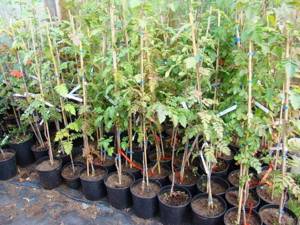
The way the common rowan looks, especially at the peak of its beauty, on fine autumn days, makes this tree very noticeable. It is so attractive that it is widely used in landscape design. The trees look good as a background for ornamental shrubs (spirea, fieldfare, dogwood, barberry). Small trees look great as tapeworms on lawns and are great next to gazebos. A rowan planted in the front garden acts as a talisman for the house against all sorts of misfortunes.
It goes well with oaks, lindens, fir, spruce. It makes excellent living gazebos. Varieties of weeping rowan created by grafting are cozy forms of landscape design. In our nursery of ornamental plants and seedlings, all varieties of rowan are grown. What a rowan tree a client likes looks like can be found in the company’s online catalog with a photo and description of the plant. Call us. The company will help you choose the plant you like with delivery to your address and a payment form convenient for the client.
We will send the material by email
Rowan is a conspicuous tree with an openwork crown, pleasing the eye with clusters of bright berries. For many centuries it was considered a magical plant and was planted near the house for protection against evil forces. Nowadays, ornamental rowan still decorates household plots, although it is valued not as a magical plant, but as an ornamental and functional plant.
Planting and care
Decorative rowan, a shrub or tree, is traditionally planted along the perimeter of the site. The plant is unpretentious, but will grow and bear fruit especially well on light loamy soils. In order for the plant to successfully take root, the following rules are observed:
- For planting in the ground, nurseries offer seedlings with rootstock (up to 2 years old) and large seedlings (up to 8 years old). The latter successfully take root in any climatic conditions.
- Planting is carried out in early spring or autumn, in moist soil. The distance between holes is left at least 5 m.
- Intensive care is required only during the disembarkation period; it consists of abundant watering. Fertilizing is carried out in the first years of intensive growth.
- Periodic care consists of trimming old, broken branches and sufficient watering in dry times.
On our website you can find contacts of construction companies that offer services for designing and performing landscape work of any complexity. You can communicate directly with representatives by visiting the “Low-Rise Country” exhibition of houses.
Reproduction
It can be propagated by seeds, cuttings, root suckers, or dividing the bush. When planting, a hole 30-40 cm deep is sufficient. Root shoots and divisions take root well. It is better to do this in spring or autumn. When choosing a place for Fieldfare, you must consider how you will limit the spread of root suckers
. This could be a 30 cm wide border strip, plastic panels, slate, in the end. It is enough to dig to a depth of 30 cm. In our case, a drainage ditch acts as a barrier. This is perhaps the only drawback of my favorite shrub.
Drainage groove limits unwanted growth of shrubs
Benefits for landscape design
Rowan is an unusually picturesque plant that can be admired all year round. In spring it pleases with lush green leaves and delicate white inflorescences, in summer and autumn with ripening berries and exciting changes in colors. In winter, when its branches are decorated with clusters of berries, the tree takes on a particularly decorative appearance. The bright plant is perfect for decorating a site, and therefore rowan is used quite actively in landscape design. Its other qualities also contribute to this:
- Versatility. Garden varieties do not grow higher than 10 m, which makes them suitable for small areas. Another plus is that rowan grows quickly; three years after planting, you will admire a full-fledged tree.
- Tolerance to living conditions. Rowan is ready to adapt to partial shade and to different soils. All that can destroy it is stagnation of moisture at the roots and dirty city air.
Rowan: description with photo, habit. Types and varieties of rowan in landscape design
Arnold's rowan (Sorbus arnoldiana Kirsten Pink)
Arnold's rowan Kirsten Pink is a large deciduous shrub, often multi-stemmed. It grows slowly. Photophilous. Not demanding on soil conditions. Frost-resistant. Resistant to urban conditions. It has an openwork crown. Used in group plantings and tree and shrub compositions.
| 5 years | 10 years | maximum | |
| Height, m | 0.80 | 1.80 | 5.00 |
| Crown diameter, m | 0.60 | 1.30 | 3.00 |
Rowan koehneana (Sorbus koehneana)
Köhne rowan is distinguished by its creamy-white fruit color. It grows slowly. Prefers fertile, slightly acidic soils. It freezes a little in harsh winters. Prefers sunny places, but tolerates partial shade. The plant looks very impressive in single and group plantings.
| 5 years | 10 years | maximum | |
| Height, m | 0.60 | 1.50 | 4.00 |
| Crown diameter, m | 0.60 | 1.50 | 4.00 |
Rowan (Sorbus aucuparia)
Common rowan is an unpretentious, frost-resistant tree. Decorative all year round with its coral-colored fruits and feathery leaves. The growth rate is fast. Not demanding on soils. Light-loving, but tolerates shade. Tolerates short-term excess moisture. Has high frost resistance. A very impressive plant in gardens and parks. Used as a tapeworm, in group plantings and tree and shrub compositions.
| 5 years | 10 years | maximum | |
| Height, m | 1.60 | 3.60 | 8.00 |
| Crown diameter, m | 1.20 | 2.70 | 6.00 |
Rowan Joseph Rock (Sorbus aucuparia Joseph Rock)
Rowan Joseph Rock is distinguished by its bright yellow fruit color. The growth rate is very fast. Prefers light, slightly acidic and well-drained soils. Photophilous. Frost-resistant. Resistant to urban conditions. It is used in single and group plantings, to create decorative groups in parks and squares.
Read also: Pelargonium fischers appleblossom description
| 5 years | 10 years | maximum | |
| Height, m | 1.50 | 3.50 | 10.00 |
| Crown diameter, m | 1.20 | 2.50 | 4.50 |
Mountain ash Pendula (Sorbus aucuparia Pendula)
Common mountain ash Pendula is an ornamental deciduous tree with a beautiful weeping crown shape. Unpretentious, frost-resistant, attractive all year round. Particularly effective during flowering and autumn. And in winter, its bright red fruits stand out in contrast against the background of white snow. The growth rate is fast. Undemanding to soil. Photophilous. Tolerates excessive short-term moisture. Frost-resistant. Used as a tapeworm.
weeping, height depends on grafting site
| 5 years | 10 years | maximum | |
| Height, m | 0.80 | 1.80 | 6.00 |
| Crown diameter, m | 0.30 | 1.10 | 4.00 |
Mountain ash (Sorbus aucuparia Fastigiata)
Mountain ash fastigiata is a small tree with a narrow pyramidal crown. It grows slowly. It is winter-hardy, shade-tolerant, but blooms and bears fruit better in sunny places. It is undemanding to soils, but does not tolerate salinity and waterlogging. Used in alley plantings, in small groups, edges and street row plantings. Ideal for creating verticals in tree and shrub compositions. Used to create seasonal compositions.
| 5 years | 10 years | maximum | |
| Height, m | 0.60 | 1.30 | 8.00 |
| Crown diameter, m | 0.20 | 0.50 | 2.00 |
Rowan Edulis (Sorbus aucuparia Edulis)
Rowan Edulis is one of the most interesting types of trees used in landscape design. The bright color of the fruits and the ability to preserve them for a long time are its undoubted advantage. Has high winter hardiness. It is photophilous, tolerates light partial shade, and does not bloom or bear fruit well in shaded conditions. Moderately demanding of soil fertility, prefers deep, fertile, loose, well-drained soils. Does not tolerate air pollution and smoke. Does not tolerate waterlogging and swampiness. Damaged by sooty fungus, this reduces decorative properties. Used in solitary and group plantings, tree and shrub groups, edges, alley plantings.
| 5 years | 10 years | maximum | |
| Height, m | 1.60 | 3.60 | 15.00 |
| Crown diameter, m | 1.00 | 2.30 | 6.00 |
Intermediate rowan (Swedish) (Sorbus intermedia)
Intermediate rowan is a slender, medium-sized tree. Unpretentious to soil conditions. Frost-resistant. Photophilous. Very resistant to urban conditions. Tolerates soil compaction. Drought resistance is average. Does not tolerate salinity and waterlogging. Ideal rowan for urban plantings.
| 5 years | 10 years | maximum | |
| Height, m | 0.80 | 1.80 | 10.00 |
| Crown diameter, m | 0.50 | 1.30 | 6.00 |
Use in landscape design
Landscape designers love the rowan tree for its variety of types and uses. In addition to the common rowan that grows everywhere, weeping rowan with its shoots hanging down to the ground is popular as decoration.
In garden plots you can also find Vilmorin rowan with amazing pearl-pink fruits, and Greek rowan, whose red fruits turn blue over time. Compositions with mountain ash in landscape design are built in a variety of ways, among the popular ones:
- Landing method. A beautiful tree is planted separately, in an open place; the second option is group. A string or circle of rowan trees is a characteristic feature of ancient Russian estates and parks.
This might be interesting! In the article at the following link, read about solving the problem of height differences in architecture.
Description of rowan-leaved shrub
Fieldfare shrub is widespread in Asia and is found in some temperate regions of Europe. This allowed breeders to develop several varieties of the crop that are widespread in North America. There are 10 varieties of fieldfare in total, but only a couple of them are most widely used in our area.
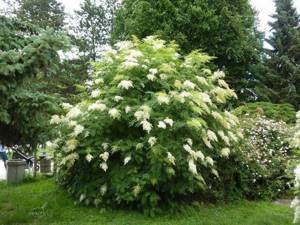
Fieldfare looks very impressive during flowering
Fieldfare leaves tend to be similar to rosebush leaves, but larger in size. The trunk is gray-yellow or reddish-brown. The plant blooms with large panicle inflorescences, consisting of many small buds of white or cream color.
Fieldfare blossom
Light inflorescences against the background of bright green leaves look very presentable. Fieldfare blooms for a long time: from early June to mid-late August. To prolong it, wilted inflorescences are removed. When used in landscape design, do not wait for the fruits to ripen, because they do not look as impressive as the inflorescences.
Fieldfare in landscape design
A plant with leaves like rowan is widely used by landscape designers. It can be successfully integrated into any composition in a garden plot or in a park.
Most often you can find fieldfare in the following form:
- the center of the landscape composition, the top of all flowers;
- hedge;
- combination with trees with a high open trunk;
- harmonious composition with coniferous trees.
Important! Beekeepers especially value fieldfare for its honey-producing abilities.
